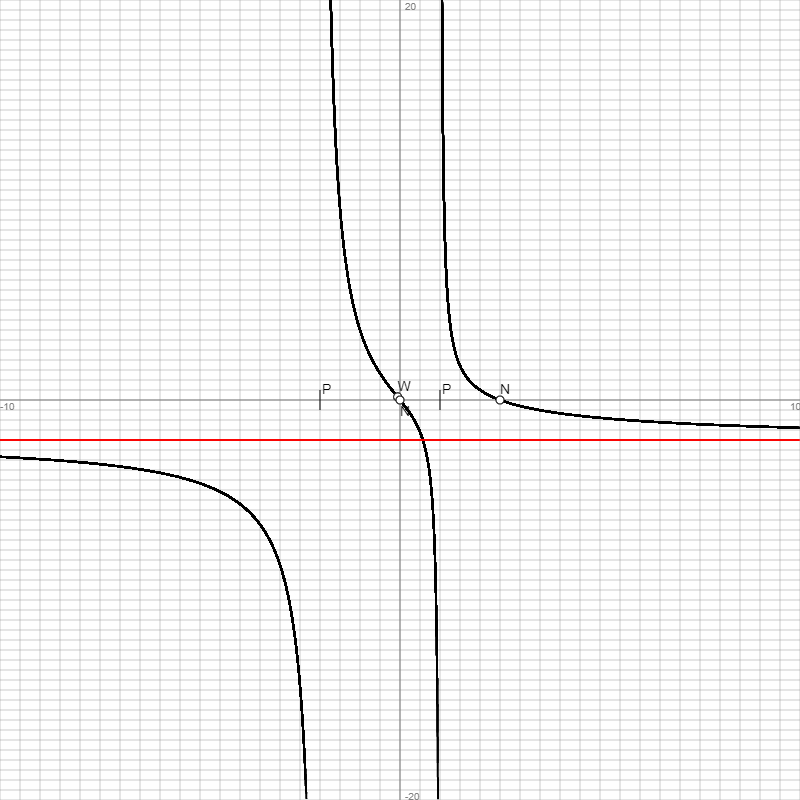 , Df = R\{-2; 1}, Wf = R, gebrochen rationale Funktion, x -> -∞: f(x) -> -2 = y als Grenzkurve, x -> +∞: f(x) -> -2 = y als Grenzkurve ->
, Df = R\{-2; 1}, Wf = R, gebrochen rationale Funktion, x -> -∞: f(x) -> -2 = y als Grenzkurve, x -> +∞: f(x) -> -2 = y als Grenzkurve ->www.michael-buhlmann.de
Funktion: f(x) =  , Df = R\{-2; 1}, Wf = R, gebrochen rationale Funktion, x -> -∞: f(x) -> -2 = y als Grenzkurve, x -> +∞: f(x) -> -2 = y als Grenzkurve ->
, Df = R\{-2; 1}, Wf = R, gebrochen rationale Funktion, x -> -∞: f(x) -> -2 = y als Grenzkurve, x -> +∞: f(x) -> -2 = y als Grenzkurve ->
| Wertetabelle: | |||||
| x | f(x) | f'(x) | f''(x) | f'''(x) | Besondere Kurvenpunkte |
| -10 | -2.8409 | -0.1 | -0.02 | -0.01 | |
| -9.5 | -2.8952 | -0.12 | -0.03 | -0.01 | |
| -9 | -2.9571 | -0.13 | -0.04 | -0.02 | |
| -8.5 | -3.0283 | -0.15 | -0.05 | -0.02 | |
| -8 | -3.1111 | -0.18 | -0.06 | -0.03 | |
| -7.5 | -3.2086 | -0.21 | -0.08 | -0.04 | |
| -7 | -3.325 | -0.26 | -0.1 | -0.06 | |
| -6.5 | -3.4667 | -0.31 | -0.14 | -0.09 | |
| -6 | -3.6429 | -0.4 | -0.19 | -0.14 | |
| -5.5 | -3.8681 | -0.51 | -0.29 | -0.24 | |
| -5 | -4.1667 | -0.69 | -0.45 | -0.45 | |
| -4.5 | -4.5818 | -0.99 | -0.78 | -0.93 | |
| -4 | -5.2 | -1.54 | -1.52 | -2.27 | |
| -3.5 | -6.2222 | -2.72 | -3.58 | -7.17 | |
| -3 | -8.25 | -6.06 | -12.03 | -36.39 | |
| -2.5 | -14.2857 | -24.08 | -96.06 | -587.85 | |
| -2 | Infinity | Infinity | Infinity | Infinity | Senkrechte Asymptote/Pol x = -2 mit Vorzeichenwechsel: x -> -2-: f(x) -> -∞, x -> -2+: f(x) -> +∞ |
| -1.5 | 9.6 | -24.16 | 95.88 | -564.92 | |
| -1 | 3.5 | -6.25 | 11.75 | -36.02 | |
| -0.5 | 1.3333 | -3.11 | 2.96 | -8.26 | |
| -0.065 | 0.1618 | -2.48 | 0 | -7.26 | Wendepunkt W(-0.06|0.16) |
| 0 | 0 | -2.5 | -0.5 | -8.3 | Nullstelle N(0|0) = Schnittpunkt Sy(0|0) |
| 0.5 | -1.6 | -4.96 | -15.23 | -98.89 | |
| 1 | Infinity | Infinity | Infinity | Infinity | Senkrechte Asymptote/Pol x = 1 mit Vorzeichenwechsel: x -> 1-: f(x) -> +∞, x -> 1+: f(x) -> -∞ |
| 1.5 | 1.7143 | -4.49 | 16.28 | -94.37 | |
| 2 | 0.5 | -1.38 | 2.19 | -6.08 | |
| 2.5 | 0 | -0.74 | 0.72 | -1.26 | Nullstelle N(2.5|0) |
| 3 | -0.3 | -0.49 | 0.35 | -0.43 | |
| 3.5 | -0.5091 | -0.36 | 0.2 | -0.19 | |
| 4 | -0.6667 | -0.28 | 0.13 | -0.1 | |
| 4.5 | -0.7912 | -0.22 | 0.09 | -0.06 | |
| 5 | -0.8929 | -0.18 | 0.07 | -0.04 | |
| 5.5 | -0.9778 | -0.16 | 0.05 | -0.03 | |
| 6 | -1.05 | -0.13 | 0.04 | -0.02 | |
| 6.5 | -1.1123 | -0.12 | 0.03 | -0.01 | |
| 7 | -1.1667 | -0.1 | 0.03 | -0.01 | |
| 7.5 | -1.2146 | -0.09 | 0.02 | -0.01 | |
| 8 | -1.2571 | -0.08 | 0.02 | -0.01 | |
| 8.5 | -1.2952 | -0.07 | 0.02 | 0 | |
| 9 | -1.3295 | -0.07 | 0.01 | 0 | |
| 9.5 | -1.3606 | -0.06 | 0.01 | 0 | |
| 10 | -1.3889 | -0.05 | 0.01 | 0 | |
| Graph: | |||||
 | |||||
Graph(en) der Asymptote(n), Grenzkurve(n).
Abkürzungen: Df = (maximaler) Definitionsbereich, f(x) = Funktion, f'(x) = 1. Ableitung, f''(x) = 2. Ableitung, f'''(x) = 3. Ableitung, H = Hochpunkt, L = Lücke, N = Nullstelle, P = Polstelle, R = reelle Zahlen, S = Sprungstelle, T = Tiefpunkt, W = Wendepunkt, WS = Sattelpunkt, Wf = Wertebereich, {.} = ein-/mehrelementige Menge, [.; .] = abgeschlossenes Intervall, (.; .) = offenes Intervall, [.; .), (.; .] = halboffenes Intervall, ∞ = unendlich.
Bearbeiter: Michael Buhlmann